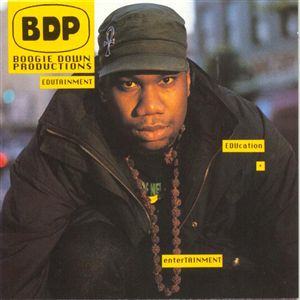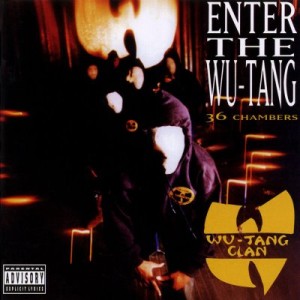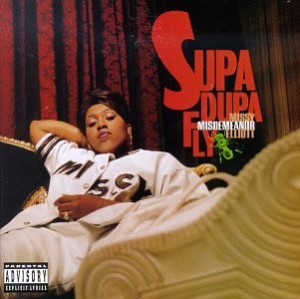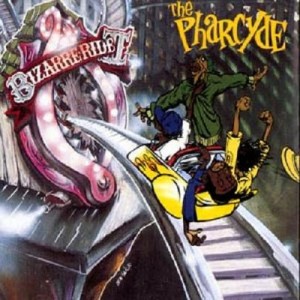Reaching its second decade proper, Hip Hop finally became an accepted part of the music business; the so-called critical cries that often labeled the genre, “a passing fad”, were silenced.
Growing from its birth and infancy period in the projects, and progressing through various incarnations, rap music had fought hard, and with tenacity, to be taken serious by the wider world; eventually gaining mainstream radio play and MTV coverage – remarkably it wasn’t until 1988 that MTV devoted a show, exclusively, to Hip Hop, in the guise of Yo MTV Raps.
The “daisy age” had helped usher in a more acceptable, and colourfully experimental, era of development, with De La Soul’s eponymous ‘3 Feet High And Rising’. Now a more viable commercial success, thanks to both the psychedelic imbued wisdom of the Native Tongues collective, and to the crossover potential of the Beastie Boys, Hip Hop looked in rude health as the 90s dawned.
Awash with incidents, events and exceptional releases; the 90s began with the white-press rattling Public Enemy opus – perhaps the most ambitious album of the whole decade – ‘Fear Of A Black Planet’ and equally biting radical, ‘To The East Blackwards’, by the Black Nationalist movement’s, equally Egyptian obsessed, X Clan.
With eager anticipation the world waited for the follow-up to De La Soul’s “Sergeant Pepper of rap” debut; but were instead treated to the post-modern death knell heralded and self-destruct pathos, ‘De La Soul Is Dead’ (91); however their Native Tongues collages, A Tribe Called Quest, recorded the cerebral conscious and meditative ‘People’s Instinctive Travels And The Paths Of Rhythm’ (90), whilst their rather less on-message compatriots in the same movement, Black Sheep, went for puerile salacious wit and confrontational stereotyped irony, on ‘A Wolf In Sheep’s Clothing’ (91).
What some believed was surely a joke; the Beastie Boys had began as hard-rock partying enthusiasts and drop-outs, infringing on the predominantly black rap scene with the highly successful one-finger call-to-arms ‘License To Ill’ in the 80s, they built up a reputation off the back of ‘Paul’s Boutique’ (89), and then reached a certain longevity and mature seriousness with the rootsy, live instrumental sound of ‘Ill Communication’ (94) – a much respected and critically acclaimed recording, that remains on most “best of the 90s” lists.
A more open style of preaching from both the Muslim scriptures, and the Afrocentric doctrine, laid out by groups such as KMD on ‘Mr.Hood’ (91), the Brand Nubians on ‘All For One’ (90), and The Poor Righteous Teachers on ‘Pure Poverty’ (91); were like a radical calls to arms for the black community – KMD would cause such alarm with their provocative ‘Black Bastards’ follow-up that the label shelved it, incensing the groups Zev Love X so much that he transformed himself into the metal-faced alter-hero MF Doom, the avenging rapper, in 1997.
KRS-One and his prolific BDP brought out the soliloquy spitting broadcast ‘Edutaiment’ (90) LP, which featured a novel re-reading of the bible, diatribes against the media, and a eulogy rich harsh lesson on materialism and gun running.
Gangstarr brought us the jazz with the double dose of ‘Step Into The Arena’, (91) and ‘Daily Operation’ (92), whilst Nas dropped the yardstick-measuring bombshell, ‘Illmatic’ (94). Staying in New York, the escapist Shaolin temple inspired antics of the Wu-Tang Clan, kept us entertained with their grimy back-to-basics hard-hitting ‘Enter The Wu-Tang: 36 Chambers’ (93), before going on to dominate the Hip Hop scene with an abundance of mythical and infamous multifaceted projects. They unleashed a star-studded line-up of underground talent, including such now legendary names as, Raekwon, GZA, Ghostface Killah, RZA, Method Man, and perhaps the craziest mother of them all, Ol’ Dirty Bastard; who all developed their own distinct solo brands, yet maintained the Kung-fu and Scarface trademark themes.
The East Coast vs West Coast – or more specifically N.Y vs L.A -battle that raged continually, though much of this was the invention of labels and the press, spilled out into a disturbing bitter grudge when the bigger-then-life producer and rapper Biggie Smalls/ Notorious B.I.G began a spat with the self-appointed “thug life” and redeemed tragic character, Tupac Shakur – a one-time associate and friend.
Shakur, aka 2-Pac, had been through the grinder; robbed, shot, convicted of sexual assault, the self-titled Machiavelli rapper was regarded as some kind of martyr by his fans; yet he always played fast and loose with the gangster label, embroiling himself with the equally infamous Death Row record boss, Suge Knight. A vitriol exchange between both camps that escalated from slurs on the character of Small’s then wife, Faith Evans, spilled out into an eventual more sinister episode, as both Shakur (in 1996) and the B.I.G (in 1997) were shot dead by unknown assailants in separate incidents. Of course this didn’t stop either men continuing to release albums every other year after their untimely deaths, from beyond the grave, as a macabre fandom craved every last scrape of their heroes.
Back in California, “Gangsta” rap and P-Funk were the rigour. Compton’s most famous sons, N.W.A, attempted to carry on after Ice Cube left – over royalties of all things – going on to produce ‘Niggaz4Life’, and spawning a million copycat imitators. Ice Cube fared well going solo with the adroit delineates explosive ‘Amerikkkas Most Wanted’, before becoming an unlikely action star of the screen. Another former N.W.A miscreant, Dr.Dre, became the “blunted” producer of choice; bringing out a raft of his own, critics favourite LPs – ‘The Chronic’ (92) among them – and mentoring, one of the 90s biggest Hip Hop artists, Eminem. In no way the best, or even most influential of MC’s, Eninem’s sardonic humour delivery was nurtured and blessed by Dre’s production, which propelled the Detroit rappers debut, ‘The Slim Shady LP’ (99) into the annals of Hip Hop forever.
Another west coast titan, Snoop Doggy Dogg, would run rampant with the all gangsta lean rhetoric, with numerous sly worded and drawling lyrics on gang-banging, brew, and rather un-PC allusions to the ladies. The hardly concealed pun-tastic introduction to the braided one, ‘Doggy Style’ (93), flew off the shelves, lapped-up mostly outside the hood by a teenage white audience.
The grand patriarch and maverick of the Cali scene, Ice-T, fought to hold onto his crown; releasing the booty-shaking throw down, ‘Original Gangster’ in 1991 to favourable reviews.
Over in the Latin quarters, a group of Cheech & Chong worshiping heavy rock loving rappers began laying down a new brand of bombastic nasal funk. Cypress Hill mixed tales of life in the projects with countless eulogies to the herb, rapped to a backing of Sabbath, Led Zeppelin and ACDC redolent samples. Their self-titled 1990 debut included sabre-rattling tunes such as, ‘How I Could Just Kill A Man’ and the riotous condemnation of the L.A.P.D, ‘Pigs’, yet by the release of their 1993 ‘Black Sunday’ tome, they were festival darlings and multi-million selling exalted crossover stars.
Aside from the obligatory gang-culture muscled gestures, fatuous humour was allowed a brief flourish in the wildstyle tomfoolery of L.A’s The Pharcyde. Their exceptional 1992 classic, ‘Bizarre Ride II The Pharcyde’, was a roller coasting, Kool-Aid trip of inventiveness, and sparring vocal interplay. Like an acid-casualty and weed-addled version of Leaders of the New School or Ultramagnatic MCs, their many knockabout comedic storytelling episodes brought a certain breath of fresh air to the macho swagger of Hip Hop.
Anyone may so far be forgiven for assuming that 90s Hip Hop was a wholly male affair: not so.
Superstar female rappers bathed in the spotlight too, with Missy Elliot at the helm. Her none-too-serious funk-in-the-trunk style of rap and visuals found favour with the MTV generation, on the ‘Supa Dupa Fly’ (97) LP. An album filed with dance-friendly spitting beats and countless guest rap spots.
Running a close second in the popularity contest was Brooklyn firecracker Lil Kim. Mentored in part by the Notorious B.I.G, Kim went from playing-up the moll’s role in the Junior M.A.F.I.A crew, to going solo with the, aptly named, ‘Hard Core’ debut in 1996 – the first album by a female rapper to reach no.1 in the Billboard 200.
Eclipsing them all in accolades and critical exuberance was the one-time Fugees member and filmstar, Lauryn Hill. Winning a boot-load of Grammys, Hill’s debut solo effort, ‘The Miseducation Of Lauryn Hill’ (98) was more soul sister then Hip Hop, yet it sold in the millions.
Talking of films, way before she appeared in, mostly, family friendly comedies, the Afrocentric matriarch Queen Latifah once ruled the roost back in the early 90s. Instead of the present blow-dry actress look took hold, Latifah ragged and blustered an entirely different agenda on the proud black-historical blast, ‘Nature Of A Sista’ (91), as part of the Native Toungue and Flava Unit umbrella. Preaching from a similar Black Nationalistic soapbox, and also bestowed with the same grandiose royal title; Queen Mother Rage, launched Black Watch tirades against the establishment, with the X Clan stewarded LP, ‘Vanglorious Law’ (91).
Shotgun blasting Yo-Yo, under the wing of Ice Cube, gave a good account of herself on ‘Motherlode’ (91) and ‘Black Pearl’ (92). Like a female version of Chuck D, her rat-a-tat bullet popping delivery style proved corrosive and brutal.
Back across the Atlantic, British Hip Hop relied on ephemeral bursts of exposure on TV, or begrudgingly in the press.
At the beginning of the 90s, MTV was still only watched by a small minority, and apart from pirate radio in the capital, mainstream stations only dedicated an hour or two a week to the genre.
Hip Hop Connection was the only dedicated publication on these shores, at the time; its pages mostly reliant on news from the states’ yet it also showcased a wealth of home-grown talent.
Armenian born street poet Blade was as sharp as his tag suggests, his hardline lyrics were tough, bleak and highly influential, on ‘Survival Of The Hardest Working’ (92) – an album only available at the time via mail order; Blade was already trying out new ways to reach an audience long before the internet.
Over in Hackney, Overlord X drew attention to the harsh realities of life in the council estates of east London, and local political issues in the community on ‘X Versus The World’ (90). Trailblazing across the UK scene, Hijack’s venomous sneering scattergun rants caught the attention of Ice-T, who signed them to his own imprint label Rhyme Syndicate in 1989, and released the Batman ironical ‘The Badman Is Robbin’ single, before producing their biblical entitled debut, ‘The Horns of Jericho’ in 1991 – unfortunately the labels real owners, Warner, failed to release it in the US.
MC Mell’O’ became our answer, in a manner, to jazz obsessive, Gangstarr, on his 1990 odyssey ‘Thoughts Released’; a soulful and much sophisticated toasting volume.
The UK scene flourished with notable underground artists and acts, including Caveman, The Cash Crew, Ruthless Rap Assassins, Black Radical MK II and Stereo MCs, all knocking out exceptional LPs and 12 inches, all turning their back on the influence of the US. Meanwhile, over in Bristol, the West Country roots and dub sound system crew, The Wild Bunch, spawned the now famous Massive Attack.
By the end of this epoch, Hip Hop was in rude health and an intrinsic part of the cultural backdrop; a commercial musical style that took over from rock and country music in the sales stakes.
As with rock, jazz, soul or electronic music, it had faced similar pressures in both re-invention and with selling-out – KRS-One mused that the original intentions of Hip Hop had all but died out and been lost. The message was watered down to a degree, and the pursuit of the mighty dollar took over. Super-super star branded artists like Jay-Z and Puff Daddy served their apprenticeships in the 90s, with a much more raw and original style then the one they entered the noughties with – though they both shifted a tidy sum of records in that decade. Thankfully an underground experimental return to form soon reared its head again with MF Doom, Edan, Stones Throw, cLOUDDEAD and Mr.Lif all producing some of Hip Hops most inventive masterpieces.





